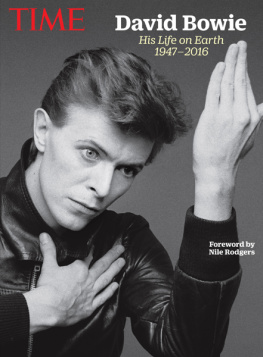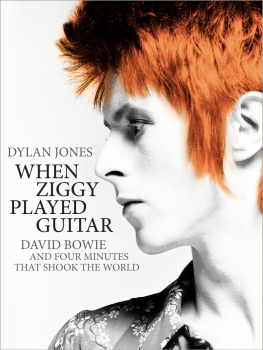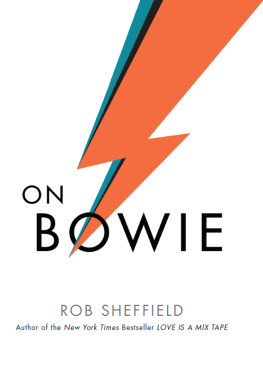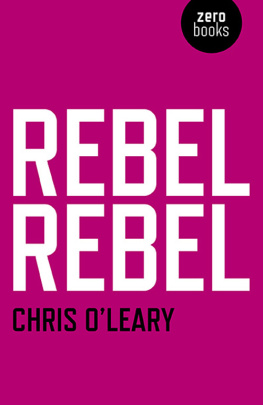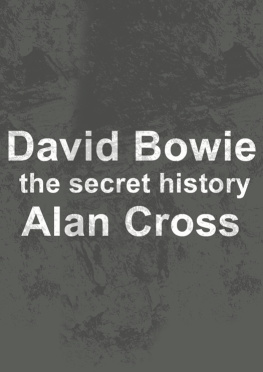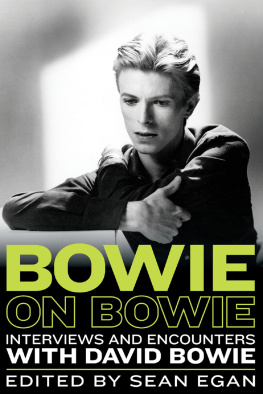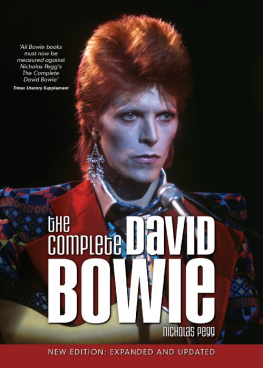Davanna Cimino - David Bowie: A Biography
Here you can read online Davanna Cimino - David Bowie: A Biography full text of the book (entire story) in english for free. Download pdf and epub, get meaning, cover and reviews about this ebook. year: 2012, publisher: Hyperink, genre: Non-fiction. Description of the work, (preface) as well as reviews are available. Best literature library LitArk.com created for fans of good reading and offers a wide selection of genres:
Romance novel
Science fiction
Adventure
Detective
Science
History
Home and family
Prose
Art
Politics
Computer
Non-fiction
Religion
Business
Children
Humor
Choose a favorite category and find really read worthwhile books. Enjoy immersion in the world of imagination, feel the emotions of the characters or learn something new for yourself, make an fascinating discovery.
- Book:David Bowie: A Biography
- Author:
- Publisher:Hyperink
- Genre:
- Year:2012
- Rating:3 / 5
- Favourites:Add to favourites
- Your mark:
David Bowie: A Biography: summary, description and annotation
We offer to read an annotation, description, summary or preface (depends on what the author of the book "David Bowie: A Biography" wrote himself). If you haven't found the necessary information about the book — write in the comments, we will try to find it.
ABOUT THE BOOK Even in the days when he was Davie (or Davy) Jones of the the Kon-Rads, King Bees or the Manish Boys (a few of his early bands) David Bowie was, and still is, a fully formed, timeless pop artist. Although he always experimented and changed stylistically, he seems to have simply burst into this world as Ziggy Stardust, Aladdin Sane, the Thin White Duke, David Bowie, and finally just Mr. Jones all rolled into one. He is a shimmering chimera changing to reflect what we hope to find, and what we dont expect to find: the romantic troubadour, the glammed outer space messiah, the burnt-out case from another world, the sophisticated, world-weary philosopher, the aging artist facing his own mortality.David Bowies best known, and most groundbreaking character is Ziggy Stardust. If the trappings of Ziggy Stardust, glam-androgyn, are stripped away, what we have left is simply great pop music. The gender-smashing concept of Ziggy as stimulating, and some would say, as freeing for society as it was isnt a bolt out of the blue for us today as it was then. What survives is the music. So the sociological effect of David Bowies depiction of gender with his character Ziggy Stardust isnt his most valuable contribution to pop music. The music is. Besides his popular success, part of why David Bowie is such a great contributor to late 20th century rock and roll is that the answer to who or what David Bowie is is a reflection of who we are. Like all great artists he shows us aspects of our own imaginations. And in an uncanny way, he has always managed to presage certain trends or events at a time when Western pop culture was changing in a way that in hindsight seems inevitable. At any given time, the shape of the future is unknown. An obvious observation, but one that needs restating in order to place ourselves more fully in the shoes of those who came before us. In 2004, Rolling Stone put David Bowie at number 39 on its 100 Greatest Artists of All Time list. His friend and sometime collaborator, Lou Reed, commented that he has a melodic sense that is just way above anyone else in rock and roll. Listen to just a few of his songs, and it becomes obvious that he is a great songwriter as well as a great performer: Space Oddity, Changes, Ziggy Stardust, Life on Mars?, Young Americans, Fame, Sound and Vision, Heroes, Lets Dance. His music varies so much over the years from the English music hall style of some of the songs on the 1967 album, David Bowie, to the American soul style of Young Americans, to the euro-rock, post punk sounds of the Berlin Trilogy, Heroes, Low, and Lodger, to mainstream hits of the 80s, Lets Dance and Modern Love, to his late career, jazz-influenced song Bring Me the Disco King.Despite the fact that he has varied his approach stylistically, Bowie explains his approach to his subject matter in this YouTube video of a Danish interview given at the start of his A Reality Tour of 2003. He has returned to the same themes throughout his life: loneliness, isolation, abandonment, spirituality, and the lack thereof. He tells the interviewer that he is fundamentally the same person that he was a teenager, except that he is three and a half inches taller. According to Bowie, he has shifted his perspective, but not his artistic preoccupations......buy the book to read more!
Davanna Cimino: author's other books
Who wrote David Bowie: A Biography? Find out the surname, the name of the author of the book and a list of all author's works by series.


